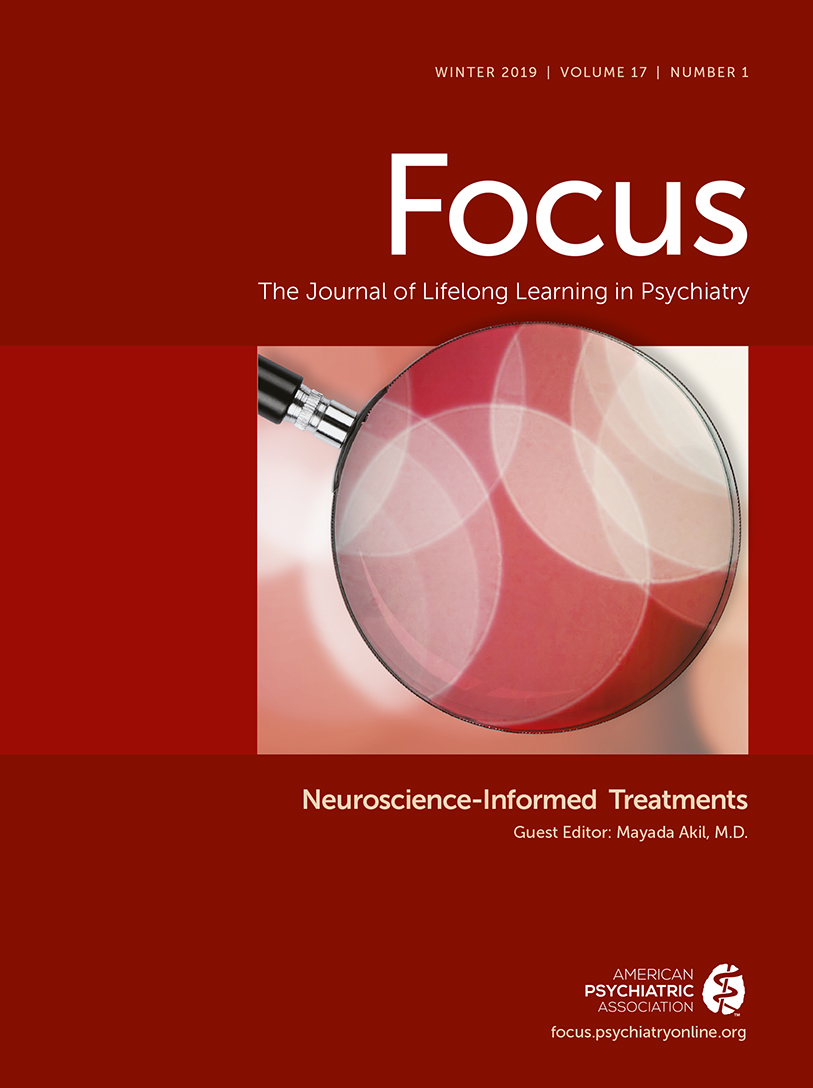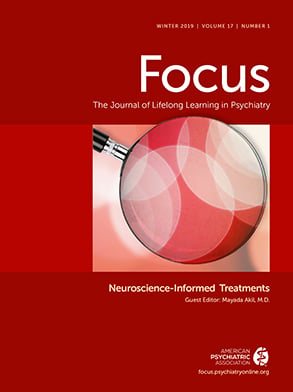It is likely that many who attempt to teach neuroscience have heard a response much like this. It is true that, despite the tremendous progress of psychiatric neuroscience over the past few decades, clinical psychiatry has been slow to expect its practitioners to have a knowledge of the basic science of psychiatry. The field has struggled to leave behind dualistic notions of mind and brain and to embrace its identity as a clinical neuroscience discipline (
1). The practice of the psychiatrist includes the evaluation of clinical disorders and the application of evidence-based treatments, be they psychotherapy, psychopharmacology, psychosocial interventions, or electroconvulsive therapy. All this is often done without attention given to the underlying pathophysiology of the disorder or the mechanisms of action of the therapeutic interventions. However, all effective psychiatric treatments have neurophysiological mechanisms, the details of which are becoming better understood.
There have been numerous calls to action for the integration of neuroscience into psychiatric practice (
2–
5). Because this transition involves a cultural change, there is recognition that integrating neuroscience perspectives into psychiatric education from the earliest stages of, and consistently throughout, training and into practice is essential. This integration requires efforts at undergraduate, graduate, and continuing medical education levels to ensure that the psychiatrists of the future appreciate the relevance of neuroscience and have the ability to incorporate further advances into their practice.
There is broad consensus from survey data that increased neuroscience teaching during psychiatric residency is desired by residents and fellows (
6), chief residents (
7), program directors (
8), and department chairs and practicing psychiatrists (
9). Despite this consensus, many residency programs feel underresourced to teach neuroscience (
8), and 79% of chief residents felt their residency did not adequately prepare them to translate future neuroscience research findings into clinical practice (
7).
Even when classroom teaching is excellent, many trainees do not see clinical mentors providing examples of how to incorporate clinical neuroscience into everyday work with patients. In this article, we first describe a framework for incorporating the language of neuroscience into everyday psychiatric practice, and we provide examples and data showing the positive effects of such an approach. Second, we review resources helping to make neuroscience more accessible to clinicians.
Neuroscience-Informed Case Formulations
The biopsychosocial formulation, as conducted by some psychiatrists, treats the “bio,” “psycho,” and “social” components as entirely separate entities. Moreover, the biological dimension is often restricted to family history and substance use. We are so used to treating what are considered idiopathic disorders that even other medical illnesses known to frequently cause or be comorbid with psychiatric symptoms and disorders are sometimes ignored.
Take, for example, a presentation of subacute, progressive fatigue; amotivation; and social isolation. These may be the clinical manifestations of an enlarging pituitary adenoma but are likely to be misdiagnosed as depression (
19). Apathy is a distinct neuropsychiatric presentation that affects some of the same neural circuits disturbed in idiopathic mood disorders, but it lacks the dysphoric affective component. Proper diagnosis requires an understanding of neuroanatomy, a history and physical exam that consider underlying pathology, and laboratory studies that can unveil hormonal contributions.
In developing the biopsychosocial model, Engel was attempting to reduce the dualism in psychiatry that separates mind and body and to promote a more integrative model (
20). In the same way that neurological lesions, such as traumatic brain injury, can produce changes in personality and mood, we know that abuse and neglect during development, for example, can have long-term psychological and physiological effects that are mediated by the brain through epigenetic modifications in the hippocampus. These effects result in altered hypothalamic-pituitary-adrenal axis function as well as reduced neurogenesis and changes in the gene expression of neurotrophic factors (
21). Therefore, training psychiatrists to think holistically and to understand the interactive role of the brain and mind would lead to clinicians who are able to embrace complexity and find interventions that take into account interrelated proximal and distal factors affecting patient outcomes.
Integrating the Language of Neuroscience Across the Spectrum of Psychiatric Interventions
When most clinicians think of using neuroscience in the practice of psychiatry, they are likely to envision neuroimaging devices, such as functional magnetic resonance imaging; neuromodulatory devices, such as repetitive transcranial magnetic stimulation; or even neuropharmacological interventions, such as selective serotonin reuptake inhibitors. A broader view of clinical neuroscience, however, includes interventions that are less explicit in their targeting of the brain—interventions often described as psychosocial or psychotherapeutic.
The language of neuroscience and even the term itself do not obviously lend themselves to many effective and evidence-based psychotherapeutic or psychosocial interventions for psychiatric disorders. Yet research has demonstrated that interventions such as cognitive-behavioral therapy (
22), aerobic exercise (
23), deep breathing (
24), and mindfulness (
25) have demonstrable and measurable effects on the brain and nervous system.
For example, an effective treatment for sleep disorders, cognitive-behavioral therapy for insomnia restores normal prefrontal cortex activity during cognitive tasks (
26). Behavioral activation therapy (BAT), an effective treatment for depression, has been shown to alter activity of neural circuits that mediate the response to rewards, including the orbitofrontal cortex (
22). This provides a potential mechanism for alleviating anhedonia.
Acceptance and commitment therapy (ACT), which incorporates elements of BAT as well as mindfulness techniques, is an effective treatment for both addiction and chronic pain disorders (
27,
28). A recent study of patients with opioid addiction showed that ACT also successfully altered activity in key brain regions. ACT treatment reduced activation in pain-processing regions of the brain, including the insula and anterior cingulate cortex (
29). Given the present opioid epidemic and the prevalence of chronic pain disorders, it is helpful to have nonpharmacological treatments that target the brain circuitry involved in pain.
In addition, ACT has been shown to modulate the brain’s default-mode network (DMN), a circuit that includes parts of the medial prefrontal cortex and the posterior cingulate cortex. DMN activity represents the resting state of the brain—there is greater activity when the brain is not engaged in a specific task. Greater connectivity—or correlated activity between brain regions—is linked to depressive rumination (
30). In research, ACT has resulted in reduced DMN connectivity and reduced rumination (
29).
Behavioral interventions, such as deep breathing exercises, have been shown to be effective in dealing with posttraumatic stress disorder (PTSD) symptoms (
31), resulting in increased parasympathetic activity and a reduction in stress hormones (
24). On a related note, there is some evidence that yoga is helpful for anxiety, and its anxiolytic effects correlate with production of γ-aminobutyric acid—the neurotransmitter system targeted by antianxiety medications such as benzodiazepines (
32).
Similarly, aerobic exercise has been shown to be beneficial in treating symptoms of depression and has myriad effects throughout the brain and nervous system. First, aerobic exercise has been shown to increase parasympathetic activity in depression (
33) and reduce stress hormones (
34). Second, it has been shown to increase hippocampal neuroplasticity in both rodents and humans (
35,
36), an effect also caused by antidepressant medications (
37). Last, aerobic exercise has been shown to modulate activity in circuits contributing to habits (striatum) and motivated behavior (orbitofrontal cortex) (
23), which potentially explains its benefits in alleviating lack of motivation and maladaptive habits associated with depression.
In addition, interventions using positive psychology have also been shown to improve mental health outcomes and alter neural activity (
38–
40). For example, in one study, adding a gratitude-letter writing exercise to traditional psychotherapy resulted in changes in rostral anterior cingulate cortex activity that were observable even three months later (
40). The anterior cingulate cortex is an element of the limbic system that plays important roles in mediating communication between the prefrontal cortex and the rest of the limbic system. Activity in the rostral anterior cingulate is linked to subjective happiness and thus might provide an explanatory mechanism for how gratitude expression might facilitate the experience of positive emotions (
41).
Psychiatric disorders are brain disorders, and communicating this fact to patients can help reduce stigma and blame (
42). However, clinicians should also make clear to patients that their biology is not entirely fixed. Educating patients about the malleability of their neurobiology has been shown to increase perceived agency and reduce pessimism (
43). There are many means to modulate the brain’s synaptic structure and function, including epigenetic changes; neuroplasticity; and even more immediate effects of the patient’s activities, relationships, and environment.
The clinician’s behavior also has the power to affect the patient’s neural circuitry, for better or worse. Stress exacerbates most psychiatric conditions, but the clinician has the opportunity to provide a supportive social interaction, which has been shown to reduce the cortisol response to stressful situations (
44). A supportive interaction also facilitates a sense of trust (
45), which can potentially harness the neuroprotective and anxiolytic effects of oxytocin (
46). Although there is not always a clear path to establish rapport and connection, recognizing the effects on the patient’s brain is an important first step.
Helping people become aware of their emotions can also positively affect key neural circuits. Emotional awareness results in ventrolateral prefrontal cortex activation that correlates with reduced amygdala activity (
47). This suggests that the simple act of awareness can recruit the cognitive parts of our brain to reduce the intensity of negative emotions.
The tendency to artificially identify some treatments as “neuroscience informed” and others as psychotherapeutic or psychosocial is therefore incorrect and misleading. Although not all psychiatric interventions were developed with neuroscience in mind, they all work through the brain. Advances in neuroscience provide explanatory evidence for why these interventions work. Because there is a desire by both clinicians and patients alike for interventions to be supported by neuroscience, it is helpful to be explicit about the fact that these interventions have known neuromodulatory effects. In this article, we provide four examples of how to discuss a range of psychiatric treatments using neuroscience-informed language (
48–
52) (
Box 1).
Resources for Practicing Neuroscience-Informed Psychiatry
Over the last quarter century, there have been substantial leaps in knowledge of the neurobiology of psychiatric disorders. However, much of the knowledge remains couched in the complex language of basic science literature and has thus been inaccessible to clinicians. Recently, there have been significant efforts to make accessible resources that translate the primary neuroscience to the language of clinical psychiatry. Some of this is happening in the traditional journal-based psychiatric literature, such as the educational review of the neuroscience of PTSD (
53). A series of clinical commentaries in
Biological Psychiatry have also reviewed a diversity of topics, including appetite regulation (
54), the
N-methyl-
d-aspartate receptor’s role in memory and psychosis (
55), and the habenula’s role in depression (
56).
A major push to create accessible educational materials for teaching psychiatric neuroscience has come from the National Neuroscience Curriculum Initiative (NNCI). The NNCI is a collaboration between psychiatric educators and neuroscientists, with the goal of helping “train psychiatrists to integrate a modern neuroscience perspective into every facet of their clinical work” (
57). NNCI learning modules are free and open access. In addition to modules intended for classroom settings, there are many short educational videos that can be watched in a few minutes in the clinical setting.
Of particular relevance to bringing neuroscience to the bedside are the two NNCI series of modules titled “Talking Pathways to Patients” and “Clinical Neuroscience Conversations,” which use patient-centered language to help clinicians distill the neurobiology for their patients. Modules of these types include videos on borderline personality disorder, addiction, functional neurological disorder, and attention-deficit/hyperactivity disorder (
58). The NNCI website also contains examples of how to conduct integrative case conferences that bring clinical neuroscience perspectives into biopsychosocial formulations. (
59)

